False jaws are nothing new. Every machinist worth his salt is aware of their use. The beauty of false jaws in the context of rim turning is that every time you set up, you can assure that the jaws that grip your work are as nearly perfectly concentric to the spindle as possible.
The expanding jaw chuck featured in this and other articles is the Talon Chuck by the OneWay company in Canada. It is shown here with the optional Jumbo Jaws. The Jumbo Jaws have slots for mounting false jaws. The way the slots are configured makes it necessary to maintain two sets of false jaws:
- External jaws pulling towards the center for gripping the outer diameter, and
- Internal jaws pushing outward away from the center for gripping the inner diameter
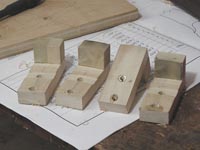 |
Here is a set of external false jaws. They are made of poplar. Notice the threaded brass inserts. Originally I tried using wood screws. The wood screws proved unreliable because the jaws are frequently taken off, readjusted or swapped for the set of internal false jaws. The holes soon became enlarged and the wood screws did not grip sufficiently. The brass inserts work really well and can be taken out and reused when the false jaws reach the end of their usefulness. |
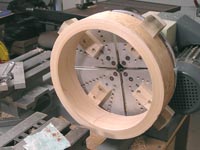 |
This shows a rim blank held in place by external false jaws. I can use a boring bar to cut the depth of the inner diameter in one pass. |
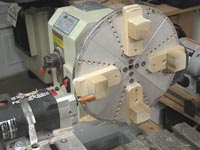 |
In this picture I have swapped the external jaws for internal jaws. The router is trimming the jaws. This guarantees that the jaws are concentric with the axis of the lathe spindle. |
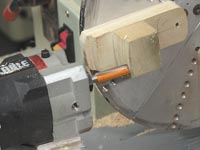 |
A closeup. |
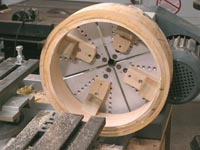 |
Here the internal jaws are in place and trimmed. They are gripping the rim blank and, because the inner diameter was already turned, the rim is ready for some very accurate machining. |